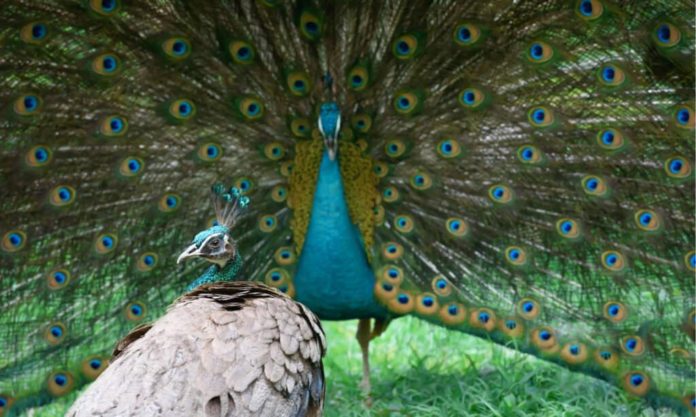Last Updated on December 30, 2023 by Fumipets
Male vs Female Peacocks
The main distinction between male and female peacocks is that the male is officially referred to as a peacock and the female as a peahen. Peafowl is the correct word for all of these species, regardless of their gender. You can tell which peafowl you are engaging with by observing a few additional characteristics between the sexes. We go through four key distinctions between male and female peafowl that you should be aware of.
At a Glance
Male
- Average length (adult): 7.5 ft including tail
- Average weight (adult): 9- 13 pounds
- Lifespan: Up to 20 years
- Family-friendly: No
- Other pet-friendly: Rarely
Female
- Average length (adult): 3.5 ft including tail
- Average weight (adult): 6 – 9 pounds
- Lifespan: Up to 20 years
- Family-friendly: Not advised
- Other pet-friendly: Rarely
Coloring
The pigmentation of the two sexes of peafowl is the most noticeable distinction. The males are the most alluring of the two, with vivid blue and/or green feathers that, when they are completely extended, are difficult to look away from. During mating season, their vivid feathers are intended to entice females.
Feathers on female peafowl might be completely blue or green or are at least more subdued than those on males. Many females have dark or gray feathers, which aid them in hiding from predators when they approach too closely. Peahens have white bellies, whereas peacocks have blue or green stomachs to match their plumage.
Sizing
The size of a peafowl might also reveal the sex of the bird. Peacocks normally weigh between 9 and 13 pounds once they reach adulthood and are substantially bigger than peahens. Females often weigh 6 to 9 pounds. When fully mature, the male peafowls are likewise around a foot longer than the females. Another distinction is tail size.
The peacock has a long, colorful tail that may reach a spectacular length of 75 inches. Females have tails that are between 2 and 6 inches shorter. They are unable to spread their tails out like their male colleagues because their tail feathers are dull. During mating season, the male’s tail comes in useful and aids in providing protection from predators.
Head and Neck
The blue feathers on a peacock’s long, graceful neck resemble silky fur. Peahens also have long necks, but they have feathers that resemble scales more than fur since they are often bluish or green in color. Boys cannot fluff the feathers on their necks as girls can. Additionally, their ocular markings differ somewhat.
Both sexes have prominent white markings above and below the eyes, although the patterns under the eyes of females usually match the color of their skin, making them harder to discern than those beneath the eyes of males. Additionally, a peafowl’s head crest has different feathers depending on the sex. Long shafts that extend upward from the bird’s head and support tiny clusters of feathers make up the crest. Males normally have blue crest feathers, while females commonly have brown or tan ones.
Actions
Male and female peafowl behave differently throughout the day. Males fan their tails out anytime they wish to attract a female’s attention or make a good impression. When battling with other peahens or warning other peafowl of danger nearby, females ruffle their tail feathers rather than fan them. While females tend to the young and construct nests throughout the day, males spend the majority of their time alone. Peafowl females tend to be friendlier than males, but they are also often more territorial.
Conclusion
The next time you encounter a bunch of peafowls congregating, you should be able to identify the males from the females within a short period of time. Do you have any other suggestions about how to distinguish between male and female peafowl? If so, please feel free to mention it below in the comments.

















